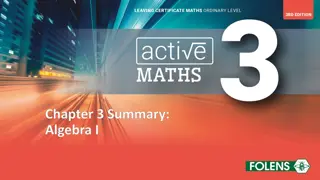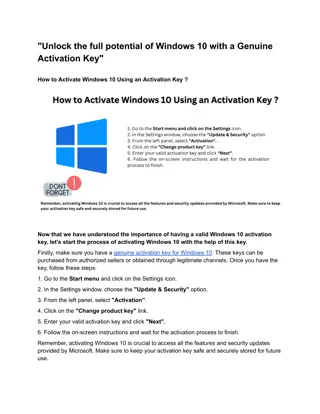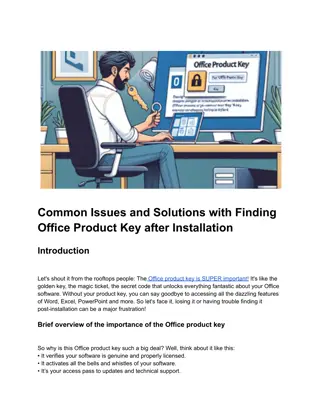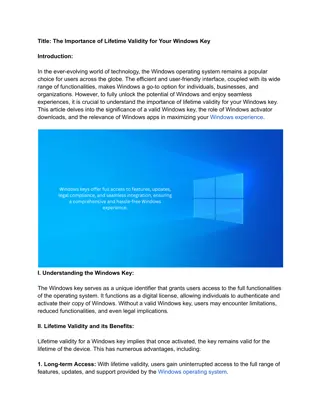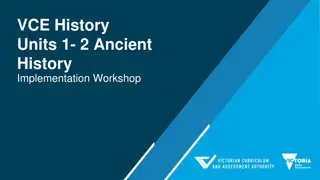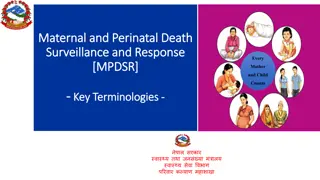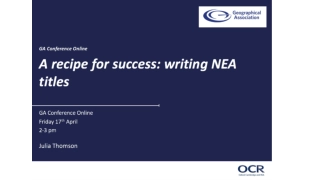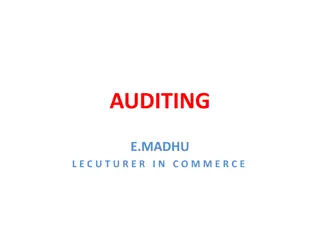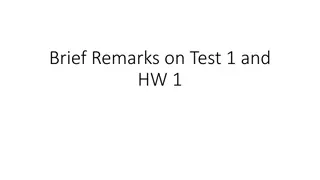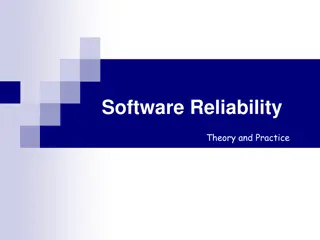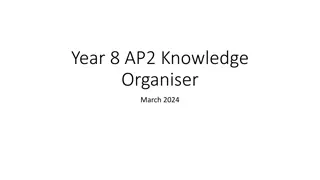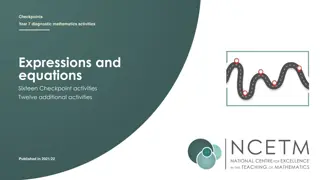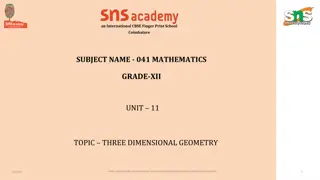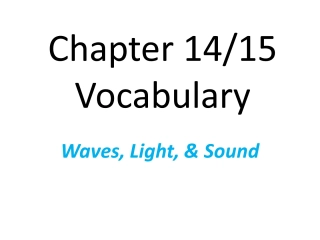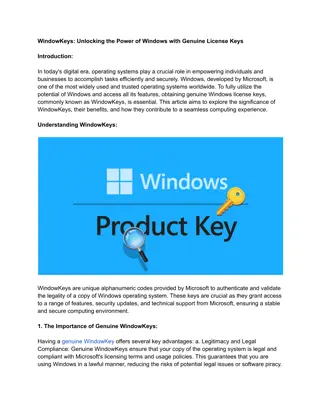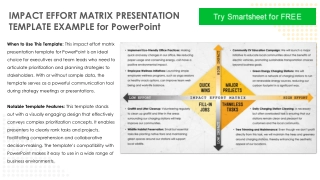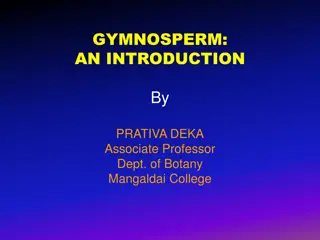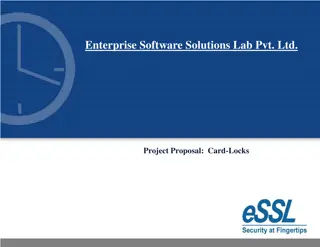Understanding H.264/AVC: Key Concepts and Features
Exploring the fundamentals of MPEG-4 Part 10, also known as H.264/AVC, this overview delves into the codec flow, macroblocks, slices, profiles, reference picture management, inter prediction techniques, motion vector compensation, and intra prediction methods used in this advanced video compression standard. From partitioning for inter prediction to interpolation accuracy and prediction modes for luma and chroma components, this guide aims to provide insights into the intricate workings of H.264/AVC.
Understanding H.264/AVC: Key Concepts and Features
PowerPoint presentation about 'Understanding H.264/AVC: Key Concepts and Features'. This presentation describes the topic on Exploring the fundamentals of MPEG-4 Part 10, also known as H.264/AVC, this overview delves into the codec flow, macroblocks, slices, profiles, reference picture management, inter prediction techniques, motion vector compensation, and intra prediction methods used in this advanced video compression standard. From partitioning for inter prediction to interpolation accuracy and prediction modes for luma and chroma components, this guide aims to provide insights into the intricate workings of H.264/AVC.. Download this presentation absolutely free.
Presentation Transcript
Introduction to MPEG-4 Part 10 (H.264/AVC) [1]
Slices And Macroblocks Macroblocks (MBs) : 16x16 luma, 8x8 chroma Macroblock partitions: 16x16, 16x8, 8x16, 8x8 Sub-macroblock: 8x8 Sub-macroblock partitions: 8x8, 8x4, 4x8, 4x4 Slices I slice Contain only I MBs P slice Contain I or P or skipped MBs B slice Contain I or B or skipped MBs SI slice SP slice [3]
H.264 Profiles The Baseline Profile I / P slices, CAVLC Video telephony, conferencing and wireless communication The Main Profile I /P /B slices, CABAC Broadcast television, storage The Extended Profile SI / SP slices, CAVLC, error resilience Streaming
The Baseline Profile Reference Picture Management Two reference picture lists: 0 for P while 0 & 1 for B List 0: closest past then closest future List 1: closest future then closest past Sliding window memory control Short-term (default) and long-term Compared with MPEG-Visual, more choices (16x2) Flushed once receiving IDR (instantaneous decoder refresh) picture
Inter Prediction Partitioning Tree structured motion compensation Trade off
Inter Prediction Interpolation Motion vector accuracy Quarter-sample resolution for luma One-eighth-sample resolution for chroma Interpolation Six tap FIR (1, -5, 20, 20, -5, 1) / 32 (luma) Mean value (luma) Bilinear interpolation (chroma)
Inter Prediction Motion Vector Compensation Case 1: same size DPCM Case 2: arbitrary size follow the rules shown below Case 1 Case 2
Intra Prediction Prediction Mode Luma prediction 4x4: 9 modes 16x16: 4 modes Chroma prediction 8x8: similar to 16x16 luma except difference in mode index
Intra Prediction Prediction Mode Contd Implementation of extrapolation in different modes [4]
Intra Prediction Mode Prediction Prediction mode need to be predicted as well Most probable prediction mode = min A,B If either of neighboring blocks are not available, set as 2 (DC) Two flags prev_intra4 4_pred_mode rem_intra4 4_pred_mode If prev_intra4 4_pred_mode = 1 prediction mode = Most probable prediction else if prev_intra4 4_pred_mode = 0 and rem_intra4 4_pred_mode < Most probable prediction prediction mode = rem_intra4 4_pred_mode else if prev_intra4 4_pred_mode = 0 and rem_intra4 4_pred_mode >= Most probable prediction prediction mode = rem_intra4 4_pred_mode + 1
Intra Prediction Residual Transform DCT-based integer transform Using only addition, subtraction and shift Factorized Where d = c / b = sqrt(2) Simplify d as 0.5 and scale 2ndand 4throws
Intra Prediction Quantization QP = [0,51] . Qstep doubles when QP increases by 6 To further simplify , where and Integer implementation: ,where f = 2?????/3 for Intra and 2?????/6 for Inter Inverse: , where V = Qstep PF 64
Intra Prediction DC Coefficient Transform Perform Hadamard Transform to DC coefficients if predicted in 16x16 Luma: 4x4, Chroma: 2x2 Case: 4x4 Case: 2x2
Deblocking Filter In-loop filter Boundary strength Determined by whether p / q is intra / inter coded and is MB boundary or not Is filtered only if BS > 0 |p0 q0| < and |p1 p0| < and |q1 q0| < , and QP are positively correlated Post-filter Not defined in CODEC will be filtered won t be filtered
Entropy Coding Parameters are encoded using Exp-Golomb codes Except residual block data Entropy_coding_mode 0 for CAVLC (baseline profile) 1 for CABAC (main profile)
Entropy Coding Exp-Golomb Coding [M][1][INFO] M = floor(log2[code_num + 1]) INFO = code_num + 1 2M Decoding:
Entropy Coding CAVLC TotalCoeffs: number non-zero value 4 Tables determined by nC nC = round ((nA+ nB) / 2); = 0 if neither is available Trailing ones: numbers of ones in reverse order, if > 3, choose last 3 Levels: non-zero coefficients other than trailing ones prefix + suffix suffix length is adaptive Total_zeros Run_before Trailing ones Levels
Main Profile B slices Buffer index are sent in Exp-Golomb Coding i.e. closer picture order count requires shorter codes Prediction mode Bi-prediction mode Direct mode (No MVs transmitted) Temporal spatial temporal direct mode
Main Profile Interlace Processed by 32x16 macroblock pairs Alternative scan order [5]
Main Profile CABAC Four binarization method Unary code Truncated unary code kth-order Exp-Golomb code Fixed-length code Binarize with table when |mvdx| < 9; else use Exp-Golomb Coding . Scale down frequency if counts > threshold
Extended Profile SI/SP Slices To switch between different bitrate Fast-forward & rewind SI can be used for different sequence
Error Resilience Data partitioning Slices / Slice groups Arbitrary slice ordering Flexible macroblock ordering Redundant slices
Data Transportation Video Coding Layer (VCL) Network Abstraction Layer (NAL) Raw Byte Sequence Payload (RBSP) (NALU) 12 types
Extended Profile Data Partitioning Coded data is partitioned into 3 parts A: slice header, MB header B: residual data for intra C: residual data for inter Unequal protection
The Baseline Profile Flexible Macroblock Ordering (FMO) Aim to reduce error Assign order other than the scan order (ASO) 7 types in total 6 types are defined 1 type left as user-defined Dispersed Foreground & Background Interleaved
Conclusion Variable block size for motion compensation Quarter pel accuracy motion compensation Enhanced temporal prediction more choices on referencing frames and flexibility on ordering In-loop deblocking filter Spatial intra prediction Efficient entropy coding CAVLC, CABAC Integer transform
Reference [1] G., R.I.E. (2012) The H.264 Advanced Video Compression Standard. Chichester: Wiley. [2] Sriram Sethuraman. Tutorial: The H.264 Advanced Video Compression Standard. Retrieved from https://www.ittiam.com/wp- content/uploads/2017/12/H.264_Advanced_video_compression_standard.pdf [3] D. Marpe, H. Schwarz, and T. Wiegand, Context-based adaptive binary arithmetic coding in the H.264/AVC video compression standard, IEEE Transactions on Circuits and Systems for Video Technology, vol. 13, no. 7, pp. 620 636, Jul. 2003, doi: https://doi.org/10.1109/TCSVT.2003.815173. [4] Anil Kumar C. Intra Prediction Algorithm for Video Frames of H.264 Nat. Volatiles & Essent. Oils, 2021 [5] 2004



